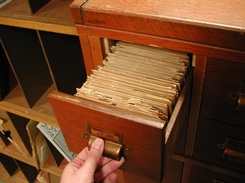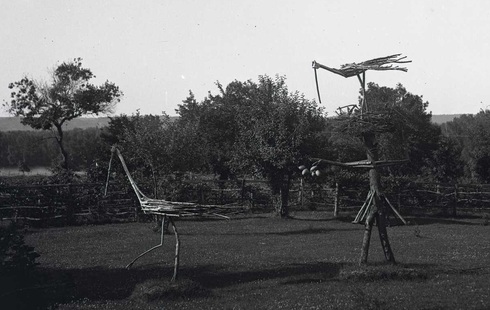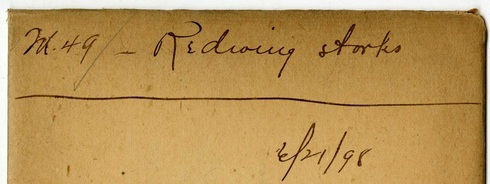On May 29, 2013, the student scanners in Digital Library Services (DLS) began scanning Drawer #1 of the 56 drawers that contain the more than 6,000 glass plate and film negatives in the Bell Museum records. A mere 8 months later, January 2014, DLS returned the final drawer to University Archives. Scanning is complete. However, we are not finished with this collection, and it’s all because of the mystery negatives we found in the last six drawers.
 We previously shared how the negatives were originally organized -placed inside captioned envelopes, numbered, and stored sequentially in drawers. Well, that is the case for the first 50 out of 56 drawers. The negatives contained within drawers 51-56 are not so nicely arranged. Only some of the negatives are numbered, but those that are do not follow the standard sequential numbering system found in the first 50 drawers. Each numbered negative also has the prefix “M.” The “M numbers” (as I refer to them) aren’t in order, and are interspersed within the last six drawers in no particular order.
We previously shared how the negatives were originally organized -placed inside captioned envelopes, numbered, and stored sequentially in drawers. Well, that is the case for the first 50 out of 56 drawers. The negatives contained within drawers 51-56 are not so nicely arranged. Only some of the negatives are numbered, but those that are do not follow the standard sequential numbering system found in the first 50 drawers. Each numbered negative also has the prefix “M.” The “M numbers” (as I refer to them) aren’t in order, and are interspersed within the last six drawers in no particular order.
Drawers 51-56 also contain an abundance of prints, stereoscopes, and strips of motion picture film, materials not found in the first 50 drawers. Much of this miscellaneous media was loosely placed within these drawers, and they are not enclosed in envelopes. So much for captions, titles, or any type of discernable descriptive information!
Here is an example of a negative from drawer 52:

Here is an image of the envelope that the negative is contained in, with (thankfully) a hand-written caption:

Redwing storks? Is it just me, or are you seeing what I’m seeing – elaborate hand-constructed lawn ornaments?
If you have been following Exploring since May 2013, you may remember that the bulk of the negatives were produced by Thomas Sadler Roberts, museum curator and director, and date back to when Roberts purchased his first camera in the late 1890s. The majority of the negatives contain images that depict the flora and fauna of the state of Minnesota. However, Roberts produced several hundred negatives prior to becoming associate curator of the Zoological Museum in 1915, and natural history wasn’t his only subject. The “M numbers,” unnumbered, and loose negatives found within drawers 51-56 contain images of subjects unrelated to Roberts’s avocation turned occupation – family members, personal vacations, neighbors, etc. Roberts took portraits of his children as they aged, mothers and infants (his medical patients), neighbors, and scenes from vacations in Bermuda and Florida. When Roberts came to the University in 1915, he brought with him his personal library of books, field notebooks and journals, and ALL of his glass plate negatives, which are now part of the Bell Museum records.
So what about the “Redwing storks” negative? The presence of a date on the envelope is helpful because we can turn to Roberts’s journals to determine where he happened to be on June 21, 1898. Box 5 of the Bell Museum records contains Roberts’s field notebook from June1898, in which Roberts kept notes from his “Trip down Mississippi River.” Though the journals are written more as annotated checklists of bird observations, and less as overall descriptions of the details of a particular trip, he did consistently note dates and locations. Found within a page of this particular journal is an entry that begins, “Birds seen at Red Wing June 21, 22, 23, 1898.”
Roberts recorded 59 different species of birds on the three days he was in Red Wing, and produced almost 50 negatives that capture them. Drawer 7, which contains negatives 601-700, is where you will find these negatives, along with others that Roberts produced in Reno and La Crescent while on his “Trip down Mississippi River” in 1898.
Why the “Redwing storks” negative was separated from the other negatives produced on the trip, labeled “M.49,” and placed in drawer 52, we may never know. Roberts’s journal entry doesn’t include an observance of wooden storks. Who made the storks, where they were located in Red Wing, and how Roberts came to find them, remains a mystery – which may very well be what “M” stands for.
Stay tuned to Exploring for more mysteries. We have six drawers full of them.